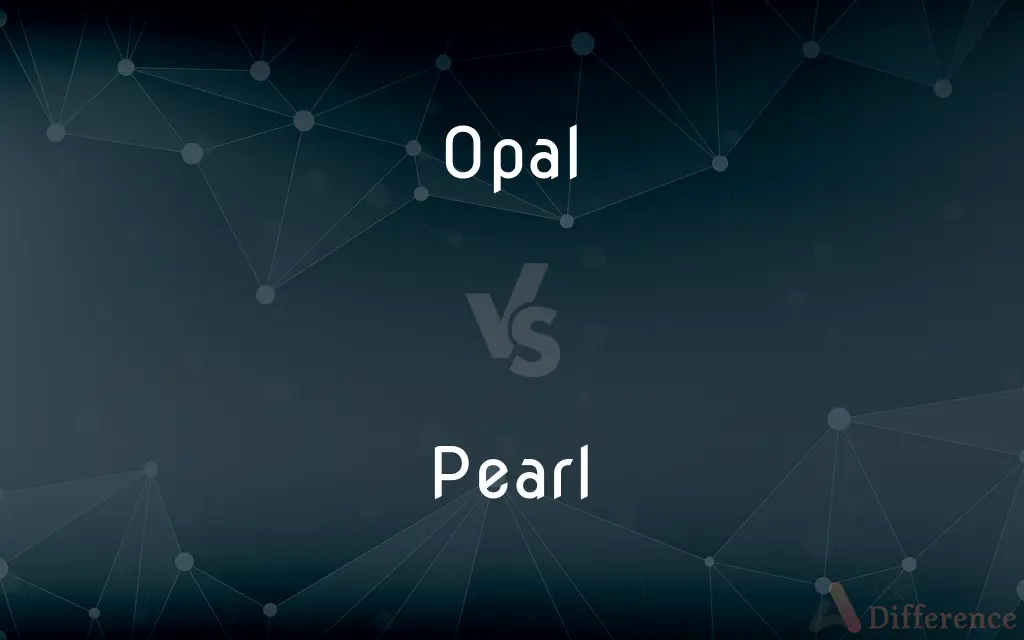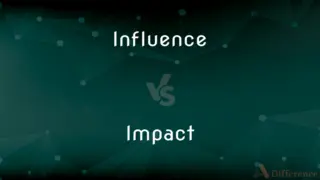Opal vs. Pearl — What's the Difference?
By Tayyaba Rehman — Updated on October 19, 2023
Opal is a colorful, iridescent gemstone derived from silica. Pearl is a lustrous, spherical gem created by mollusks. Both symbolize purity and beauty.

Difference Between Opal and Pearl
Table of Contents
ADVERTISEMENT
Key Differences
Opal is a unique gemstone known for its play-of-color or iridescence. On the other hand, Pearl is formed within mollusks as a response to an irritant, resulting in a shimmering, spherical stone. Both are considered precious in jewelry.
Opal, primarily composed of silica and water, often exhibits a spectrum of colors in different patterns. Pearl, in contrast, gets its luster from layers of nacre, a combination of calcium carbonate and conchiolin, produced by the mollusk.
Opal sources primarily include Australia, which is known for producing the finest opals. Pearls can be found in various parts of the world, including freshwater and saltwater varieties, each having distinct characteristics.
Opal has been believed to bring luck, creativity, and spontaneity to its wearer. Pearl, on the other side, has been associated with purity, innocence, and wisdom. Both stones have a rich history and significance in different cultures.
Opal is typically cut into cabochons to best display its brilliance. Pearl, being naturally spherical or near-spherical, is typically drilled and strung for jewelry. Both opal and pearl require special care to maintain their beauty.
ADVERTISEMENT
Comparison Chart
Composition
Silica with water
Calcium carbonate and conchiolin
Origin
Primarily from mineral deposits
Formed in mollusks
Appearance
Iridescent with play-of-color
Lustrous and spherical
Primary Source
Australia
Worldwide in freshwater and saltwater
Symbolic Meaning
Luck, creativity, spontaneity
Purity, innocence, wisdom
Compare with Definitions
Opal
A birthstone for those born in October.
As an October baby, she cherished her opal jewelry.
Pearl
A lustrous gemstone formed within mollusks.
The pearl necklace she wore gleamed with an ethereal beauty.
Opal
A hydrated form of silica with a play-of-color.
The opal is a complex gemstone, containing tiny spheres of silica.
Pearl
A result of layers of nacre deposited around an irritant.
The grain of sand inside the mollusk turned into a beautiful pearl over time.
Opal
A gemstone sensitive to heat and pressure.
Avoid exposing your opal to extreme conditions to maintain its brilliance.
Pearl
A symbol of purity and elegance.
Wearing a pearl ring on her wedding day was a family tradition.
Opal
A precious gemstone known for its iridescence.
The opal in her ring shimmered with a myriad of colors.
Pearl
A birthstone for those born in June.
Being a June baby, she always wanted a pearl pendant.
Opal
A symbol of hope and creativity.
She wore an opal necklace as a token of inspiration.
Pearl
A precious stone requiring gentle care.
It's best to store your pearl jewelry away from other hard gemstones.
Opal
Opal is a hydrated amorphous form of silica (SiO2·nH2O); its water content may range from 3 to 21% by weight, but is usually between 6 and 10%. Because of its amorphous character, it is classed as a mineraloid, unlike crystalline forms of silica, which are classed as minerals.
Pearl
A pearl is a hard, glistening object produced within the soft tissue (specifically the mantle) of a living shelled mollusk or another animal, such as fossil conulariids. Just like the shell of a mollusk, a pearl is composed of calcium carbonate (mainly aragonite or a mixture of aragonite and calcite) in minute crystalline form, which has deposited in concentric layers.
Opal
A gemstone consisting of a form of hydrated silica, typically semi-transparent and showing many small points of shifting colour against a pale or dark ground
A large opal surrounded by small diamonds
An opal ring
Pearl
A hard, lustrous spherical mass, typically white or bluish-grey, formed within the shell of a pearl oyster or other bivalve mollusc and highly prized as a gem
A linen garment decorated with pearls
A pair of pearl earrings
Necklaces of amethyst and pearl
Opal
A mineral of hydrated silica.
Pearl
A person or thing of great worth
He has some pearls of wisdom to offer
Opal
A gemstone made of this mineral, noted for its rich iridescence.
Pearl
Another term for picot
Opal
(mineral) A mineral consisting, like quartz, of silica, but inferior to quartz in hardness and specific gravity, of the chemical formula SiO2·nH2O.
Pearl
Form drops resembling pearls
Raindrops pearled on water-soaked windowpanes
Opal
(gemology) A precious gem, an iridescent gemstone found in the opal-silica mineral substrate (potch)
Pearl
Dive or fish for pearl oysters
The pearling industry
Opal
A colloquial name used in molecular biology referring to a particular stop codon sequence, "UGA."
Pearl
A smooth, lustrous, variously colored mass, chiefly of calcium carbonate, formed around a grain of sand or other foreign matter inside the shell of certain bivalve mollusks and valued as a gem.
Opal
Any of various lycaenid butterflies of the genus Nesolycaena.
Pearl
A bead resembling one of these masses.
Opal
A mineral consisting, like quartz, of silica, but inferior to quartz in hardness and specific gravity.
Pearl
Something small and spherical in shape
"pearls of sweat beading on her upper lip" (Katherine Min).
Opal
A translucent mineral consisting of hydrated silica of variable color; some varieties are used as gemstones
Pearl
Mother-of-pearl; nacre.
Pearl
One that is highly regarded for its beauty or value.
Pearl
(Printing) A type size measuring approximately five points.
Pearl
A yellowish white.
Pearl
To decorate or cover with pearls or beads resembling pearls.
Pearl
To make into the shape or color of pearls.
Pearl
To dive or fish for pearls or pearl-bearing mollusks.
Pearl
To form beads resembling pearls.
Pearl
Variant of purl2.
Pearl
A shelly concretion, usually rounded, and having a brilliant luster, with varying tints, found in the mantle, or between the mantle and shell, of certain bivalve mollusks, especially in the pearl oysters and river mussels, and sometimes in certain univalves. It is usually due to a secretion of shelly substance around some irritating foreign particle. Its substance is the same as nacre, or mother-of-pearl. Round lustrous pearls are used in jewellery.
Pearl
(figuratively) Something precious.
Pearl
A capsule of gelatin or similar substance containing liquid for e.g. medicinal application.
Pearl
Nacre, or mother-of-pearl.
Pearl
A whitish speck or film on the eye.
Pearl
A fish allied to the turbot; the brill.
Pearl
A light-colored tern.
Pearl
One of the circle of tubercles which form the bur on a deer's antler.
Pearl
The size of type between diamond and agate, standardized as 5-point.
Pearl
A fringe or border.
Pearl
(obsolete) A jewel or gem.
Pearl
(figurative) A valuable little nugget of information; especially, an aphorism or tip#Etymology 5 that is operationally useful for decision-making.
Pearl of wisdom
Clinical pearls
Pearl
The clitoris.
Pearl
To set or adorn with pearls, or with mother-of-pearl.
Pearl
(transitive) To cause to resemble pearls in shape; to make into small round grains.
To pearl barley
Pearl
(transitive) To cause to resemble pearls in lustre or iridescence.
Pearl
(intransitive) To resemble pearl or pearls.
Pearl
(intransitive) To hunt for pearls
To go pearling
Pearl
To sink the nose of one's surfboard into the water, often on takeoff.
Pearl
Of the nose of the surfboard: to sink in this manner.
Pearl
A fringe or border.
Pearl
A shelly concretion, usually rounded, and having a brilliant luster, with varying tints, found in the mantle, or between the mantle and shell, of certain bivalve mollusks, especially in the pearl oysters and river mussels, and sometimes in certain univalves. It is usually due to a secretion of shelly substance around some irritating foreign particle. Its substance is the same as nacre, or mother-of-pearl.
Pearl
Hence, figuratively, something resembling a pearl; something very precious.
I see thee compassed with thy kingdom's pearl.
And those pearls of dew she wears.
Pearl
Nacre, or mother-of-pearl.
Pearl
A fish allied to the turbot; the brill.
Pearl
A light-colored tern.
Pearl
One of the circle of tubercles which form the bur on a deer's antler.
Pearl
A whitish speck or film on the eye.
Pearl
A capsule of gelatin or similar substance containing some liquid for medicinal application, as ether.
Pearl
A size of type, between agate and diamond.
Pearl
Of or pertaining to pearl or pearls; made of pearls, or of mother-of-pearl.
Pearl
To set or adorn with pearls, or with mother-of-pearl. Used also figuratively.
Pearl
To cause to resemble pearls; to make into small round grains; as, to pearl barley.
Pearl
To resemble pearl or pearls.
Pearl
To dive or hunt for pearls; as, to go pearling.
Pearl
A smooth lustrous round structure inside the shell of a clam or oyster; much valued as a jewel
Pearl
A shade of white the color of bleached bones
Pearl
A shape that is small and round;
He studied the shapes of low-viscosity drops
Beads of sweat on his forehead
Pearl
Gather pearls, from oysters in the ocean
Common Curiosities
How is a pearl formed?
A pearl is formed within mollusks due to layers of nacre deposited around an irritant.
Is opal considered lucky?
Yes, opal has been historically considered a stone of luck and creativity.
What is an opal?
Opal is a colorful, iridescent gemstone primarily made of silica.
What colors can pearls come in?
Pearls can range from white, black, pink, to golden, among other shades.
What does a pearl symbolize?
Pearls symbolize purity, innocence, and wisdom.
How can I tell if a pearl is real?
Real pearls are typically cooler to touch, have slight imperfections, and a gritty feel when rubbed against teeth.
Where are the best opals sourced?
The finest opals are primarily sourced from Australia.
Why is the opal iridescent?
The play-of-color in opal is due to the diffraction of light off its internal silica spheres.
What's the difference between cultured and natural pearls?
Cultured pearls are formed with human intervention by placing an irritant inside mollusks, while natural pearls form without any human interference.
Can opals get wet?
Yes, but prolonged exposure to water might damage an opal.
Can I wear my opal and pearl jewelry daily?
While they can be worn, both opal and pearl are softer gemstones and may require extra care to prevent damage.
Are freshwater pearls less valuable than saltwater pearls?
Generally, saltwater pearls are more valued due to their luster and roundness, but freshwater pearls have their unique charm.
Can opals change color over time?
Opals can lose their play-of-color if they dry out, but they don't change colors like some other gems.
How long does it take for a mollusk to produce a pearl?
It can take several months to many years, depending on the type and size of the pearl.
Do opals have any healing properties?
Some believe opals promote emotional healing and stimulate creativity, though this is based on folklore.
Share Your Discovery

Previous Comparison
Mean vs. Meaning
Next Comparison
Influence vs. ImpactAuthor Spotlight
Written by
Tayyaba RehmanTayyaba Rehman is a distinguished writer, currently serving as a primary contributor to askdifference.com. As a researcher in semantics and etymology, Tayyaba's passion for the complexity of languages and their distinctions has found a perfect home on the platform. Tayyaba delves into the intricacies of language, distinguishing between commonly confused words and phrases, thereby providing clarity for readers worldwide.
















































